flooring
Laminate vs. Vinyl Flooring: Home Comparison Guide
There are few things more exciting than beginning a home renovation project. But before you can watch your dream kitchen come to life before your eyes, you need to make a lot of design decisions, one of which is the type of kitchen flooring you’re going to install.
If you’re looking for a durable and aesthetically-pleasing flooring option that is also affordable, look no further than laminate and vinyl flooring. Both of these options will check off all of your must-haves, meaning that it’s important to understand the difference between laminate and vinyl to determine which is the right choice for you. Follow along as we help you decide if laminate or vinyl is better suited for your home remodel.
Vinyl vs. Laminate Flooring Pros & Cons
If you’re in the market for new kitchen flooring, you’re likely trying to figure out which flooring option is best suited for your needs. Both laminate and vinyl flooring offer different benefits, helping you narrow down which one can bring your vision to life — both in how it looks and functions. Vinyl and laminate flooring are both known for being affordable and DIY-friendly, there are a number of differences between the two choices that are important to know before making your decision.
Installation
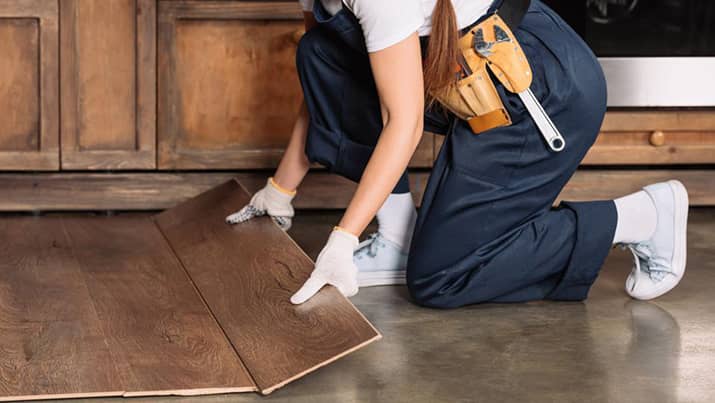
Depending on your kitchen remodeling budget, you may be opting to install your flooring yourself to save a few dollars — we get it! Luckily, you can’t go wrong with vinyl flooring or laminate flooring because they are both relatively easy to install as a do-it-yourself project.
Vinyl flooring tiles come in a variety of shapes and patterns. As a result, vinyl flooring offers a few different installation methods depending on the particular product you’ve selected. The most common installation method for vinyl flooring is click-and-clock planks, but you may also find some that are peel-and-stick or glue-down.
Laminate flooring is extremely easy to install for DIYers because it can be placed over the top of your existing floors and uses a click-and-lock installation method. Each of the laminate planks has grooves, allowing each plank to easily adhere to its neighboring plank. When clicked and locked into place, the seam between the planks is closed.
Appearance
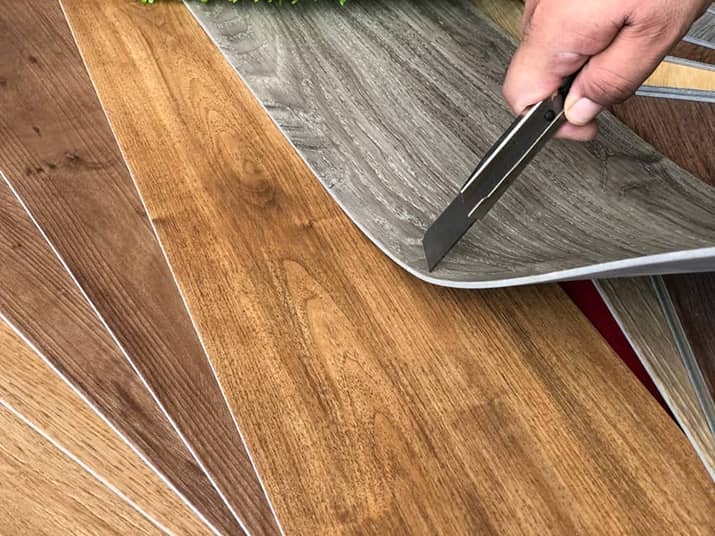
Appearance plays a big factor in your kitchen flooring decision. Maybe you like the look of hardwood but don’t want the maintenance that comes with it. Both vinyl and laminate offer that. When deciding between laminate and vinyl, it’s recommended you look at the offerings of both to see which appearance matches your desired aesthetic.
Vinyl flooring is manufactured from synthetic materials such as fiberglass and PVC vinyl. Using embossing techniques, vinyl can give a wood-like appearance to give you the look you crave without the headache of upkeep. Vinyl also offers a huge selection of styles, textures, colors, and sizes that will allow you to customize the kitchen floor to your exact specifications.
Laminate flooring is created of wood byproducts and the top layer is sealed with a resin to protect the flooring from wear and tear. Similar to vinyl, laminate flooring comes in a variety of colors, patterns, and textures that give the appearance of wood. However, because laminate flooring tends to be thicker than vinyl flooring, it offers a softer tread for those walking or standing on it.
Water Resistance
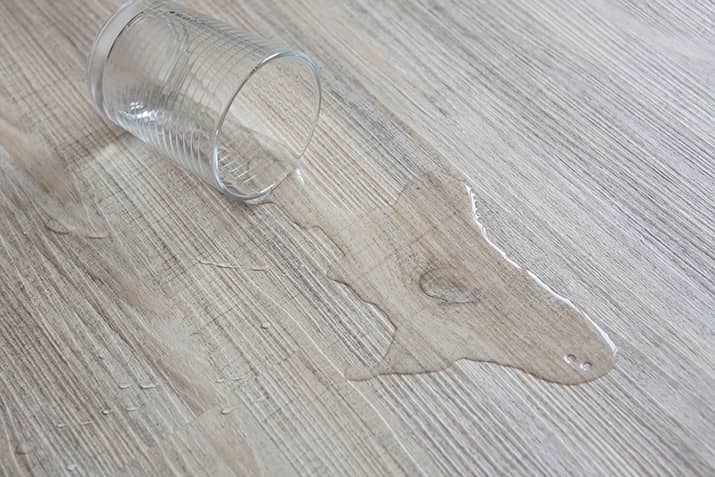
One of the biggest differences between vinyl and laminate flooring is water resistance. If this is an important factor for you, listen up!
Because vinyl flooring is manufactured from polymer materials, you can have peace of mind knowing that your kitchen flooring is set to withstand large amounts of water. Vinyl flooring can be exposed to water and will dry normally due to its composition. An added benefit of vinyl is that you can install large sheets of vinyl for an entire room, versus smaller individual pieces, meaning there are fewer seams where water can seep through and cause damage.
This is one of the few times that laminate flooring doesn’t match up with vinyl. Due to being made from fiberboard, laminate flooring does not stand up to water and will get damaged from exposure. While your kitchen floors likely won’t be subjected to as much moisture as they would in a laundry room, bathroom, or mudroom, you may still face a problem down the line if there is a leak with any of your appliances.
Cost
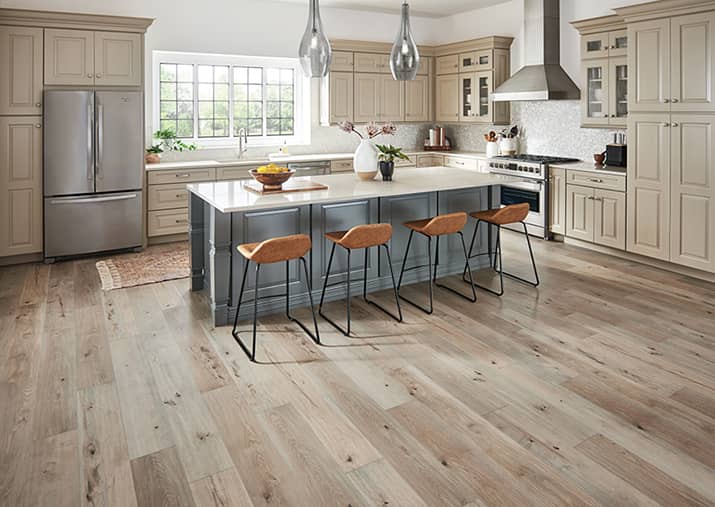
Cost is an important factor when selecting your kitchen flooring, especially if you’re working within a tight budget. Both laminate flooring and vinyl flooring are cost-effective options, especially in comparison to hardwood or tile (which often require professional installation or additional materials such as grout).
Laminate flooring often runs anywhere from $1 – $5 per square foot. The cost will vary depending on your design preferences and the thickness of the materials. Similarly, vinyl flooring runs from $1 – $5 per square foot — varying greatly in quality between the different price points. Prices will be much less for glue-down sheets versus luxury vinyl flooring options.
Durability
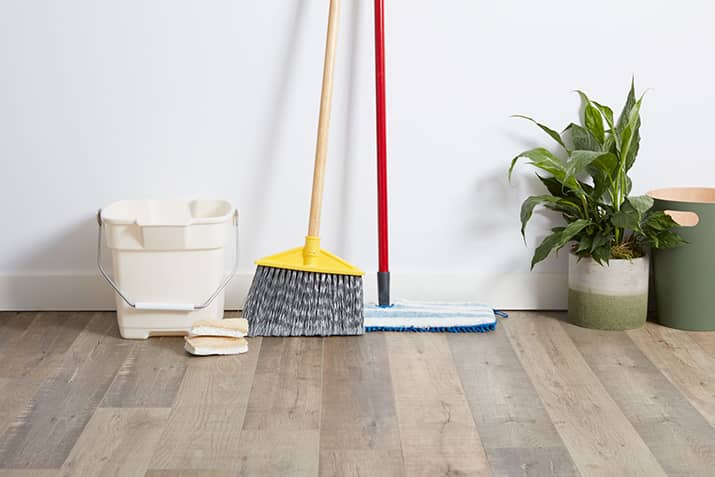
A big factor in your decision is likely the durability of the flooring. You don’t want to spend your time or hard-earned money on flooring that isn’t going to last!
The biggest risk to laminate flooring is its susceptibility to water damage. With proper care and ongoing maintenance over the years, you can expect your laminate flooring to keep looking its best for 15 to 25 years.
Vinyl flooring is resistant to everyday wear and tear — it’s scratch, dent, and waterproof. Because of this, you can have peace of mind when hosting large family gatherings or when you have children constantly running through the space. Even with its affordable price point, you don’t have to worry about its ability to hold up to pets, children, and more. With proper vinyl flooring care and maintenance, your new vinyl flooring will look as good as the day it was installed for many years to come (lasting up to 20 years!).
Laminate vs. Vinyl Flooring FAQs
Does laminate or vinyl flooring impact home resale value?
In most instances, vinyl flooring will bring in a lower resale value than laminate flooring. While some high-end luxury vinyl flooring options can positively impact home resale value, laminate flooring will typically have a higher resale value.
Is laminate flooring ruined if it gets wet?
Laminate flooring is not water-resistant, meaning that if it is exposed to water the planks will become damaged. Depending on the levels of water damage, you may experience discoloration, warping, buckling, or loose planks from the moisture. The damaged area will often need to be replaced.
What type of vinyl flooring is the most durable?
If you’re considering vinyl flooring for your home renovation, you’ve likely browsed a variety of styles and types. Depending on the needs of your household, you may be looking for a durable vinyl flooring option that can withstand wear and tear in highly trafficked parts of your home. If this sounds like you, consider installing rigid core vinyl plank flooring which is one of the most durable vinyl flooring options.
What are other kitchen flooring materials?
If you aren’t sold that vinyl or laminate flooring is right for your home, consider hardwood, porcelain tile, ceramic tile, or concrete. Each of these flooring types has varying pros and cons that may suit your needs.
![See your dream kitchen in 3D [GET YOUR FREE DESIGN]](https://cdn.kitchencabinetkings.com/blog/wp-content/uploads/see-your-dream-kitchen-in-3d.webp)
![Contractor Discount Program: Offering contractors and builders special volume discounts on all applicable orders [LEARN MORE]](https://cdn.kitchencabinetkings.com/blog/wp-content/uploads/contractor-discount-program.webp)
![Explore our photo gallery [GET INSPIRED]](https://cdn.kitchencabinetkings.com/blog/wp-content/uploads/explore-our-photo-gallery.webp)
![What everyone is saying about KCK [READ REVIEWS]](https://cdn.kitchencabinetkings.com/blog/wp-content/uploads/what-everyone-is-saying-about-kck.webp)
![Get a cabinet sample [SHOP SAMPLES]](https://cdn.kitchencabinetkings.com/blog/wp-content/uploads/get-a-cabinet-sample.webp)
![Pay over time, on your terms with Affirm [LEARN MORE]](https://cdn.kitchencabinetkings.com/blog/wp-content/uploads/pay-over-time-on-your-terms-with-affirm.webp)